The Vancouver Courthouse, bordered by Georgia, Hornby, Howe and Robson, was designed by celebrity architect Francis Rattenbury in 1907 and completed in 1911. Since 1983, it has been home to the Vancouver Art Gallery. Pamela Post wanted to know what sat on the site before. What she found was nothing and everything.
By Pamela Post
The answer surprised both me and the archivist at Vancouver Archives, as we peered at the old city map from the 1890s to early 1900s. Apparently, nothing.
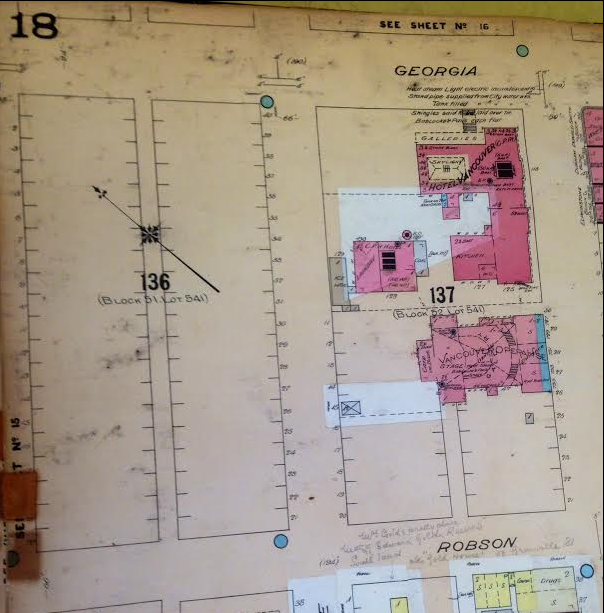
Even though the second Hotel Vancouver was next door (still awaiting its Italianate additions built from 1912 to 1916), Christ Church Cathedral just down Georgia at Burrard with houses and buildings dotting the area–the Square block bordered by Georgia, Hornby, Howe and Robson was a blank space on the map, save for the prosaic descriptor: Block 51, District Lot 541.
Until men and their horses plowed the sod for the courthouse in 1909, it was nothing but a vacant lot, lumpy clear-cut CPR land that was bought by the province to build the courthouse that would replace the 1888 structure at Hastings and Cambie.
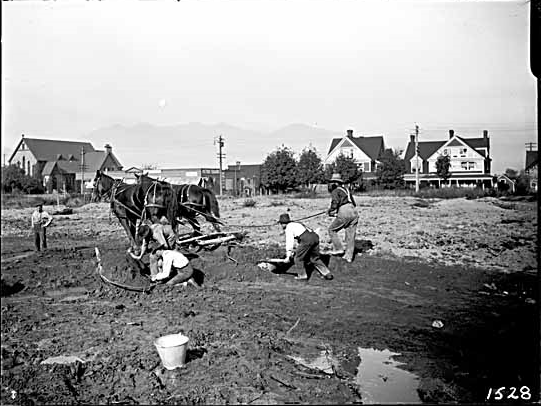
Upon its completion in 1911 the Vancouver World gushed that the building “is one of the finest in the Empire!” While a local judge told a reporter that it equaled the new Strand Courts in London, England. The colonial fervor reached its height in 1912 at the official opening ceremony which was attended by the Duke of Connaught—Canada’s Governor General.
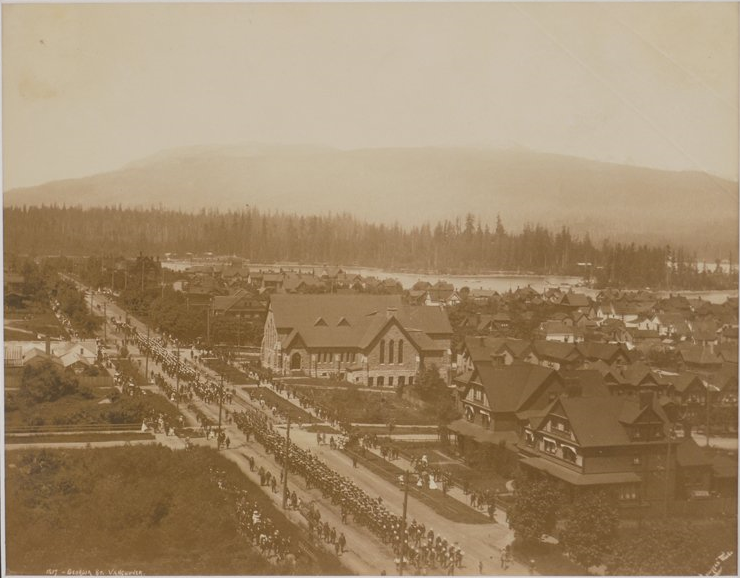
Over a century later, on this controversial Canada Day 150, the question ‘What was there before?’ demands a much deeper answer viewed through the lens of over 10,000 years of indigenous history in a place where Coast Salish peoples lived and thrived for millennia.
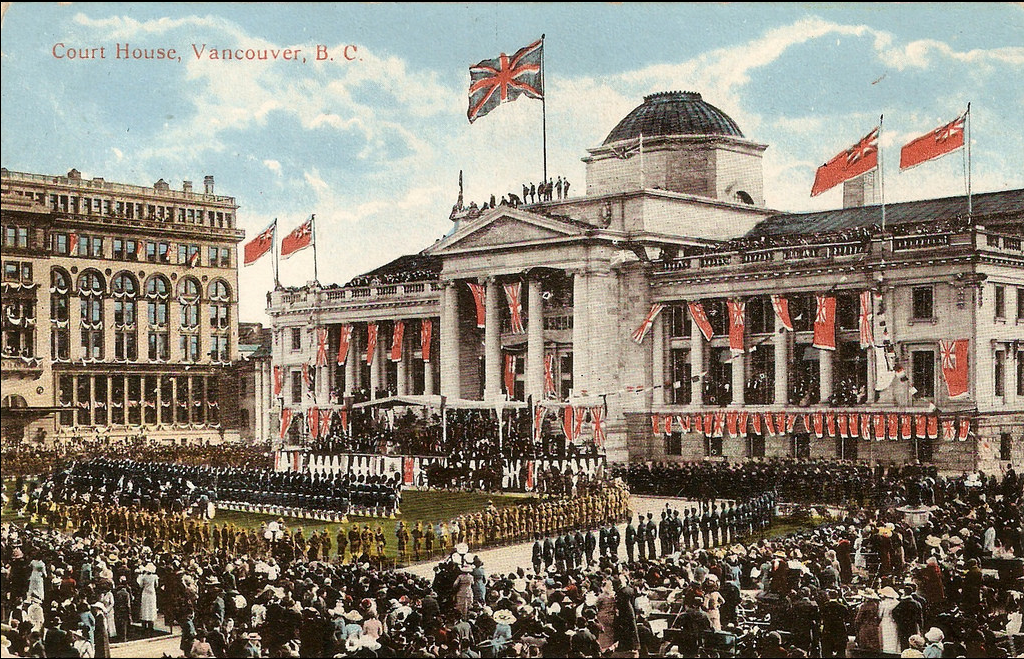
In 1996, Gitsxan artist and elder Doreen Jensen spoke to that question in an essay she wrote for an exhibition of contemporary First Nations art that she co-curated for the Vancouver Art Gallery.
“Just 112 years ago, a powerful rainforest covered the place where the Vancouver Art Gallery now stands. Trees rose 312 feet into the coastal sky. Streams made their way through the woodland where bears, beavers, wolves, elk and other animals made their homes. First Nations people were part of this complex ecosystem. They harvested trees for lumber, cutting slabs from the standing trees in a way and a season so the trees could continue to thrive.”
For decades, she writes, indigenous peoples and their cultures were treated with contempt within the walls of the Vancouver courthouse and later the VAG.
LaxHösinsxw is an important word in the Gitxsan language, writes Jensen, explaining that it means honouring and respecting others, place and space.
“In this city, at this site and at this time in history, it is a word we might learn from. The place and space in which the Vancouver Art Gallery stands, physically and metaphorically, is a contested one. Here, where a city has been incompletely exchanged for the forest and newcomers have incompletely replaced the aboriginal inhabitants, LaxHösinsxw may be key to the creative process and to our future.”
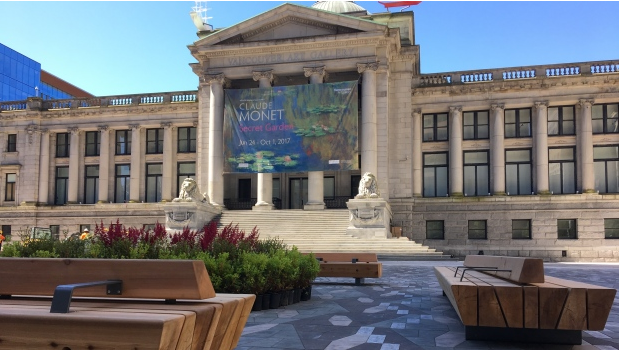 Currently, the new $9.6 million dollar plaza at the VAG showcases a very European Monet poster. I would have preferred to see the invocation Jensen wrote about that site:
Currently, the new $9.6 million dollar plaza at the VAG showcases a very European Monet poster. I would have preferred to see the invocation Jensen wrote about that site:
“The past creates an energy in the present, whether we know it or not. The ancient forest and its metamorphosis into timber, then real estate, is still part of this place.”
Pamela Post is an award-winning journalist, broadcaster and creative writer. She teaches journalism at Langara College. She was born and lives in Vancouver’s West End and is Tsimshian First Nations from Kitsumkalum on her father’s side.



9 comments on “What was there before? The Courthouse”
So interesting to see these photos. This building is such an important landmark in Vancouver with the art gallery and the open meeting spaces around it in Robson Square. It’s former history as a courthouse is also very meaningful to me as I worked in the legal field for over 20 years and I was always reminded of it’s courthouse past next to the modern court house buildings in the next blocks. The new plaza on the Georgia Street side looks great and gives more space for people to gather.
I appreciate the history of the land provided by Doreen Jensen and the taking of the land without any or proper compensation. Somehow I don’t think this land would have remained a forest but perhaps the First Nations might have been more involved in developing this land with the newcomers and prospered too.
Thanks for reading, Cathy, and thanks Eve for asking me to write this guest blog post. Cathy, I have vague memories of going to the ‘Land Registry Office’ (think those words are still carved in the Howe Street side of the building) with my realtor Dad, when I was a kid. Of course, as an adult, I knew the building as the VAG and spent much time as a CBC News reporter in the Arthur Erickson-designed Law Courts building. It was a great find to stumble onto Doreen Jensen’s powerful essay. I do hope readers click on the full essay and read it. I think her quote that I ended the piece with is one we still need to sit with, and take to heart. It asks us to walk through the streets of this city with a respect and sensitivity to the ancient Coast Salish cultures, ways, people, languages, spirituality and art that were here and prospered for millennia before European contact. Imagine ancient Greece or Egypt. We have – and had – complex civilizations even more ancient than that here, but we have expunged the memory. Doreen Jensen beckons us to remember: “The past creates an energy in the present, whether we know it or not. The ancient forest and its metamorphosis into timber, then real estate, is still part of this place.”
[…] Eve Lazarus explores the history of Vancouver’s Courthouse. […]
We have some family stories about that vacant space which the Courthouse Building filled. My grandmother and her brothers lived with their parents in a house which still stood when I was a kid, second or third from the corner on Howe Street, south of Robson Street She and her brothers had to cross that lot each day to get to school, and it was always described as the chicken farm…..someone had built both pens and runs for chickens there, and my grandmothers older brother was charged with bringing home the freshly killed chicken at lunch time, when his mother sent him off to school with the money and instructions so it was ready when he came home at noon.
My grandmother was the only girl, and she HATED being stuck with plucking these birds, and kept asking her brother to have the chicken farmer pluck it before it came home. Apparently it cost more to have it plucked and her mother insisted that this was HER responsibility around dinner preparation, and to be thankful she was allowed to go to school, now she was 12, instead of being kept home to help with the housework. It would be interesting to see if there was any mention of this Chicken enterprise in the city records, but its certainly possible that this was undertaken without much civic record!
What a fabulous story about the chicken enterprise and your poor, long-suffering 12-year-old grandmother, Susan! Thanks so much for reading the post and sharing your story. You really brought that time and place to life. I didn’t see any references to a chicken farm in my archival dig, but I did see, in a couple of photos, a few ramshackle structures on the lot. It looked like anyone could set up anything there. At the time, it was considered the ‘outskirts’ of the city, and apparently there was some dissent when the decision to build a new courthouse there was announced. City Centre then was closer to today’s Gastown or DTES. Thanks for filling in some of the ‘blank’ that was on that old city map from that period. 🙂
In the photo showing the new plaza I did not see the fountain & rock sculpture erected in the 60’s . Is it still there ? I recall marvelling at it’s reflection in the tall windows on Granville st.
I was summonsed for jury duty at the Spring Assizes at the old Courthouse in 1977, aged 29. The summons was personally delivered by a uniformed Court Sheriff, featured Latin wording, and the term “General Gaol Delivery.”I served on two B.C. Supreme Court trials, one as foreman. One of the cases was in the large, vaulted Assize courtroom, complete with clanging radiators. At the opening of that trial, the judge informed us of some of the many famous trials that took place in this room. The chairs for the jury were original; carved oak with high backs and padded seats. The building interior was incredibly intact, and lacking in modern updates. Our jury room had no electrical outlet, so the court sheriff made the coffee in an urn in the corridor, and when it was ready knocked on the door and handed it over to us. The men’s toilet room had all the original plumbing, including British made locks on the stall doors that read: VACANT or ENGAGED. There was an incredible system of extra corridors so the judges did not have to mix with the public. Doors to these locations had ornate stained glass windows that read: JUDGES ONLY.
One trial we served on was such that it was an all-male jury. We were all taken out for dinner by Court Sheriffs at the Grosvenor Hotel restaurant during deliberations, and it was all paid for unless you wanted beer or wine with your meal, and that was your responsibility. We did not reach a verdict until 11:15 pm, and when it was time to leave the courthouse all the main doors were closed. We were told we would leave by the Hornby Street cellar exit, and had to pass holding cells with barred windows. And so we did.
Both cases I was on featured Bill Deverell as Crown Lawyer, who later became a noted author in crime novels. Jury selection back then meant appearing every Monday for nine weeks. The panel was about 120 people, each with an assigned number. Mine was 58. When called, you went up to the front of the courtroom to be examined by the lawyers. No questions were asked. If selected, you were sworn in. Since this was repeated so many times over the weeks, I eventually memorised it. “Do you swear that you shall well and truly try, and true deliverance make, between our Sovereign Lady the Queen, and the prisoner at the bar, whom you shall have in charge, and true verdict give, according to the evidence, so help you God?”
I was amazed to visit the same building when it became the Art Gallery, with little remaining of the interior. The Assize Courtroom ceiling is still in place in a small room on an upper floor. I believe that one original courtroom interior was relocated to a new extension at the New Westminster Courthouse.
Angus, thank you so much for writing this, your memory for detail is astounding! (we should have done this as a blog post!)
[…] the architect who designed the Parliament buildings and the Empress Hotel in Victoria, and the Courthouse on West Georgia. It certainly looks like his work—large, gothic and creepy (Rattenbury, who was […]